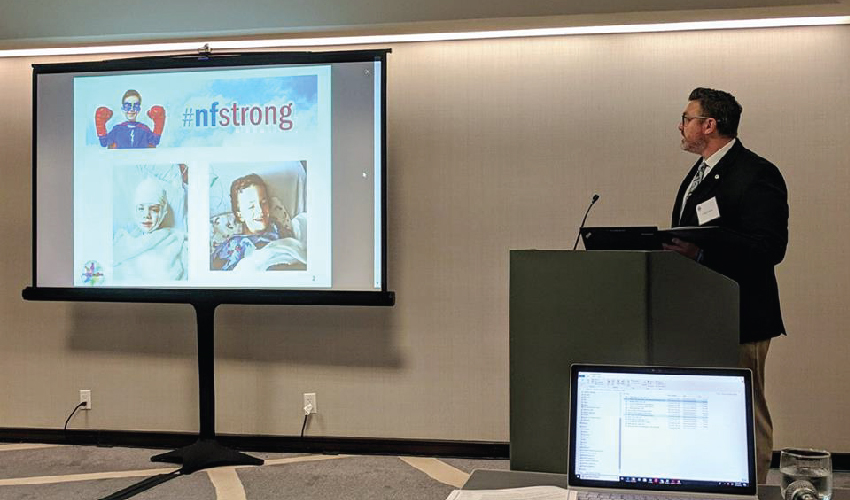REiNS Cutaneous Neurofibroma Working Group
Author: Gregg and Becky Erickson
Published On: 12/03/18

When Gregg and his wife, Becky, learned their son has Neurofibromatosis 6 years ago, they took a common first step for parents after receiving an NF1 diagnosis: they Googled “NF”. Online search results revealed imagery of patients with a relatively high burden of cutaneous neurofibromas (cNFs). These images can be difficult to absorb, knowing that 99% of patients will develop some level of cNF burden in their lifetimes. For this reason—and countless others—Gregg joined the REiNS initiative 1 year ago, knowing he wanted to be a part of the cNF working group (one of eight working groups) within REiNS.
The Response Evaluation in Neurofibromatosis & Schwannomatosis (REiNS) initiative is comprised of a group of international medical professionals and patient representatives to develop standardized response criteria for determining treatment response in patients with NF1, NF2 and Schwannomatosis. Response criteria will continue to be modified as the group gains experience in clinical trials for NF. The hope is that these criteria will be incorporated into future clinical trials and will improve the ability to determine and compare treatment efficacy.
At its bi-annual in-person meeting in December 2018, the REiNS group heard from key members of the medical community, the FDA, and patient representatives on the topic of cNFs. Current treatments for cNFs are limited and treat only a targeted subset of cNFs, resulting in scarring and potential future tumor recurrence. There exists a STRONG unmet need for the development of effective medical therapies to treat cNFs. CNFs impact nearly everyone in the NF1 population and the tumor burden varies greatly from patient to patient. There is no malignant potential with cNFs, but there can be significant negative effects on quality of life, as one can imagine.
Gregg Erickson, Executive Director of NF North Central, NF Network board member, and REiNS patient representative, was tasked with presenting the results of an NF1 population survey disseminated by the Children’s Tumor Foundation Patient Registry via email blast to adults 18 and older with NF1. The survey was designed to collect basic demographic information, details about the patients’ cNFs, views on morbidity related to specific aspects of cNFs, and views regarding current and potential future cNF treatments. Gregg accepted this charge with the great sense of responsibility to accurately relay the concerns of these 548 respondents.
The quantitative and qualitative data from the survey was extremely compelling and the REiNS group is ready to turn these concerns into new, novel therapies addressing NF1 patients’ cNF burden. Key take-aways of the survey were as follows:
- Appearance, number, location and size are the most bothersome cNF features
- Trunk and face are the most bothersome body areas
- Majority of respondents are okay with treatment that does not result in 100% clearance
- Most patients are willing to try current cNF treatments but are not aware of what is available
- The preferred modalities for experimental treatment are topical creams and oral medications
- No clear consensus for treatment frequency
- Higher burden of cNFs correlates most with treatment responses
- Limitations: not necessarily representative of the general population of individuals with NF1
- There were over 350 “free text” responses re: how and why cNFs affect the individual; a vast majority of responses touched on the psychosocial impact.
As the father of a son with NF1, Gregg found it highly compelling to review the results explicated by survey participants in the “free text” response portions of the survey. Themes included: ridicule, staring, the progressive nature of the tumors, social isolation, intimacy issues, shame and negative self image. At a minimum, NF has a serious awareness deficit as it relates specifically to cNFs. The REiNS group is anxious to meet the needs and wants of the entire NF population. Existing and future treatments will be guided by the results of this survey. The FDA knows we’re eager to meet their requirements to help expedite new, novel, effective therapies to market to treat cNFs. It is anticipated that in 2019, roughly 1,600 babies will be born with NF. That is 1,600 MORE reasons why effective cNF treatments must be realized… and sooner than later.
Want to view archived newsletters? Click Here!
Newsletter
Sign up to receive the latest neurofibromatosis news and information in your inbox!
Subscribe